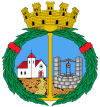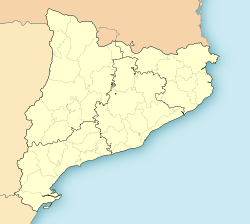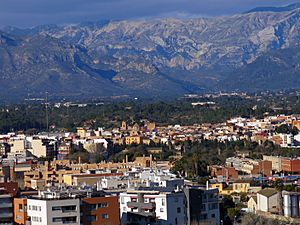Roquetes, Tarragona facts for kids
Quick facts for kids
Roquetes
|
||
|---|---|---|
|
Municipality
|
||

Roquetes parish church
|
||
|
||
| Country | Spain | |
| Community | Catalonia | |
| Province | Tarragona | |
| Comarca | Baix Ebre | |
| Area | ||
| • Total | 136.9 km2 (52.9 sq mi) | |
| Population
(2018)
|
||
| • Total | 7,961 | |
| • Density | 58.152/km2 (150.61/sq mi) | |
| Postal code |
43520
|
|
Roquetes (Catalan pronunciation: [roˈketes]) is a town in Catalonia, Spain. It is located in the Baix Ebre area of the Tarragona province. In 2018, about 7,961 people lived there. Roquetes is known for its mix of modern services and traditional rural life.
Contents
Discover Roquetes' Geography
Roquetes is the second largest town in its region, covering about 136.64 square kilometers. The town sits on the eastern side of the Ports de Tortosa-Beseit mountains. A big part of its land is inside the Els Ports Natural Park. This park includes important peaks like Mont Caro and Castell de l'Airosa.
Roquetes Through Time: A Brief History
The town of Roquetes started as an Islamic farmhouse. In 1149, Ramon Berenguer IV gave this land to Tortosa after conquering the city. This farmhouse later became known as Mas d'en Ortiz in 1603.
Roquetes officially became separate from Tortosa on March 22, 1850. This was made possible by a royal decree from Queen Isabella II. A few weeks later, on April 14, the first town council was formed. Ramon Bosch y Rosell became the first mayor.
A very important event for Roquetes was the opening of the Canal de la Dreta del Ebro on July 25, 1857. This canal helped the town's economy grow a lot. In 1880, King Alfonso XII gave Roquetes the special title of "town."
In 1885, a tram line was opened to transport animals. That same year, a serious cholera outbreak happened. More than 200 people died, and many residents moved away. Despite these challenges, Roquetes has grown into a modern town today. It offers many services and combines industrial and rural life.
Key Moments in Roquetes' Development
The Canal de la Dreta del Ebro
People dreamed of building an irrigation canal here as early as 1381. In 1441, a lack of rain caused crops to fail. This made people want a canal even more. Bishop Oto de Moncada was a key person in starting this project. However, it stopped due to his death and other problems. The project started again in 1540 when Charles V visited Tortosa.
For centuries, the canal project was started and stopped many times. Finally, in 1847, new studies began. On November 26, 1851, a company called Real Compañía de Canalización of the Ebro was allowed to do the work. The canal officially opened on July 18, 1857.
The Ebro Observatory
The Ebro Observatory was founded by the Society of Jesus. Jesuit Father Ricard Sirera started it. The observatory officially opened on September 8, 1904. It opened to the public on August 30, 1905, during a total solar eclipse. In 1920, Father Luis Rhodes took over. He made big improvements, especially in the area of seismology (studying earthquakes).
Later, the observatory became linked to the diocese of Tortosa. This changed its organization and activities. In May 1938, Father Anthony Roman y Puho became the new head. He expanded the observatory's scientific work by improving its equipment. On October 3, 1970, Father Josep Oriol Cardus took charge. The observatory was then divided into five departments: Heliophysics, Ionosphere, Geomagnetism, Meteorology, and Seismology.
Minor Seminary of Sant Josep
The Society of Jesus opened its first school for future priests in Gandia in 1906. Another school opened in Zaragoza in 1912. These two schools later combined to form the Minor Seminary of San Jose. It was founded on November 23, 1916, near the Ebro Observatory.
In 1945, the center became a seminary college, called "Colegio PP Jesuitas." It continued until the 1950s when it closed. Today, the first floor of the building is a Civic Center for the town. The second floor houses the Roquetes-Merce Lleixa Library.
The Municipal Market
The Municipal Market is one of the most important buildings from the 19th century, along with the town hall. It is located on Carrer Major street. Mayor Joan Alegret Barber decided to build it in 1892. The market started operating under a tenant who rented the service from the city council. Later, the city council took over managing the market services directly.
Municipal Slaughterhouse
The Municipal Slaughterhouse in Roquetes opened in 1921. Mayor Josep Gisbert Barber ordered its construction. It operated until the 1980s. Today, this building is the main office for the Parque Natural del Ports. It also serves as the Park's Visitor Center for the Baix Ebre area.
Roquetes' Economy
For a long time, farming was the main way people made a living in Roquetes. In the flat areas near the mountains, farmers grew olives, carob, and almonds without much water. Later, they started growing orange trees by using underground water. Around the Canal de la Dreta del Ebro, they grew fruit trees (especially oranges and tangerines), vegetables, and rice. The canal completely changed farming and the economy of the area.
Electricity came to Roquetes in 1911. This helped the town's industries grow. By 1920, Roquetes had several important factories. These included a sock factory, a wooden factory, an olive oil cooperative, a distillery, and a soap factory. Because Roquetes is close to the larger city of Tortosa, its service industry is not as big.
Education and Culture in Roquetes
Education
When the Second Spanish Republic was formed, building public schools became a big goal. In Roquetes, a teacher and politician named Marcel Domingo was very important. He was the Minister of Public Education and helped approve the school's construction. On June 17, 1934, the "El Grup Escolar Marcel·lí Domingo" school opened. It was named after him to show gratitude.
Today, Roquetes has two public primary schools: Escola Mestre Marcel·lí Domingo de Roquetes and Escola de la Raval de Cristo. There is also a secondary school called Institut de Roquetes.
The Lyra Cultural Society
The "Sociedad Recreativa y Musical la Lira" (The Lyra Recreational and Musical Society) was founded on June 24, 1907. It was started by a group of farmers who wanted to share popular culture and create workers' groups.
One of the first big things Lyra did was create a music school. Teachers Joan Cid, Frederic Zaragoza, and Mossen Josep Mirawals taught there. From this school, the Banda de Música de la Lira (Lyra Music Band) was formed in 1924. Maestro Jaume Rovira directed it. Later, Lyra also had a choir led by Joan Moreira and Ramos.
The organization added new cultural groups, including an elementary school and a theater. Since 1918, the theater has put on plays like "Don Juan Tenorio." After the Civil War, the society closed for a while. The town council took over the building, and the theater was rented out as a movie theater called Cine Alcázar. In 1967, Lyra reopened and continued its cultural activities. Today, Lyra is a very important part of Roquetes' cultural life.
Festivals and Traditions
Feast of St. Anthony the Abbot (January 17)
The Feast of St. Anthony starts with a church service. After that, animals are blessed, and a procession with horses and mules goes through the village. Then, horse races are held on the Roquetes-Jesus road. In the afternoon, there's a dance in front of the church with a performance by "Canalero" and his fables. Around 1932, plays called "Barraca de San Antonio" began. These plays stopped for a while but were brought back in 2012. Today, the Mass, horse parades, and animal blessings continue.
Main Holiday (July)
Roquetes celebrates its main holidays in the first week of July. This is the feast of Sant Gregori d'Estia, who is the town's patron saint. The first Monday in July is a local holiday.
Traditional Festival (August)
The last week of August hosts the Tradicionàrius de les Terres de l'Ebre. This is a very important folklore festival. You can enjoy live music from bands across Catalonia. There are also many events related to popular culture.
"Canalero and his Fable"
"Rondalla" is another old tradition. It involves singing improvised songs to girls, important people, or anyone who asks. The main singer was called "Lo Canalero." The songs were always made up on the spot, with four lines, and the last two lines repeated.
The most famous singer from Roquetes was Josep García Sanz, known as "Lo Canalero." He was born in Roquetes on August 4, 1914. He got his nickname because his grandfather used to supervise work on the Dretat de l'Ebre canal. Josep García Sanz believed that the beauty of the Tortosa jota song was in its improvisation. He would often sing six-line verses and signal the musicians to stop the music. He passed away on June 26, 2004.
Delicious Food of Roquetes
The food in Roquetes is rich and varied, from the mountains to the Ebro Delta. The most famous dessert in Roquetes is called "Punyetes de Roquetes." These pastries are made with flour, sugar, mistela (a sweet wine), butter, milk, eggs, lime, almonds, and anise.
On July 1, 1990, people voted to choose this pastry as the town's typical dessert. "Lo Canalero" even sang about them: "-When people eat "these" pastas are so well cooked many will ask in which village they are made and who knows will answer they are Punyetes de Roquetes."
Another important and typical dessert is "panoli," also known as cakes. These are thin, round pastries with Arabic origins. They are made from flour, oil, water, and matafaluga (aniseed).
Buildings and Landmarks
Parish Church
The Parish Church is dedicated to Saint Anthony of Padua. It was built in 1823 in a neoclassical style. The church covers 936 square meters. It has one main rectangular area and a rounded end. The central area has strong supports connected by arches. These arches make the main space feel bigger. There are also three side altars in each false side area.
The church has a simple vaulted transept (the part that crosses the main area) and ribs that meet at the highest point of the dome. In the 19th century, there were no paintings, but religious paintings appeared in the 20th century. The bell tower is square. It has four bells, each with its own name and facing a different direction.
Old Town Hall
The first stone of the Old Town Hall was laid on April 19, 1880. The building opened in 1881 under Mayor Francesco Fonollosa and Hierro. This building was important because it also served as a school and housing for teachers. Later, the ground floor became a courtyard, and the second floor became the town hall offices. It is located on Canal Street.
Today, the first floor houses the Primary Health Care Center (CAP). The ground floor has the Youth Center and Television Center. The second and third floors are home to the Roquetes Museum Center for Interpretation.
Municipal Market
The Municipal Market is on the main street. It is one of the most important 19th-century buildings after the Town Hall. Mayor Joan Alegret y Barbera built it in 1892. He managed to get the land from its owner, Alonso Ballester. The market covers 655 square meters.
Municipal Slaughterhouse
The Municipal Slaughterhouse building was designed by an unknown architect and dates back to 1922. It is a rectangular building with three U-shaped sections. The main exit leads to a central courtyard. The building has decorative pillars around its edges. The roofs are peaked on the sides and in the middle.
It always served as a slaughterhouse, except during the Civil War when it was used for military purposes. After being neglected for many years, it was restored. Today, it is the Visitor Center and Administrative Headquarters for the Del Ports Natural Park.
Raval Nova
The Raval Nova neighborhood was planned by Josep Battet. Its triangular shape led to a unique layout. A large square was built in the center, which was unusual at the time. Many long, winding paths cross High Street at right angles.
Raval de Cristo
Raval de Cristo is a neighborhood that developed later than Roquetes. The first mention of "Casas de Cristo" (Houses of Christ) was in 1860. It was listed as a suburb of Roquetes with 48 houses. This area also planned for a large central space where a church of over 800 square meters would be built.
Raval de Merce
The Raval de Merce neighborhood gets its name from buildings constructed between 1843 and 1855. These were built by Felip Merce and Balaguer, a master builder from Tortosa. In 1855, a lawyer named Ignasi Chavalera began selling land belonging to his wife and daughter-in-law here. This was the first time the Roquetes City Council used its urban planning powers in this area. This initiative helped transform Raval de Merce from a small group of houses into a planned urban area.
See also
 In Spanish: Roquetas para niños
In Spanish: Roquetas para niños




